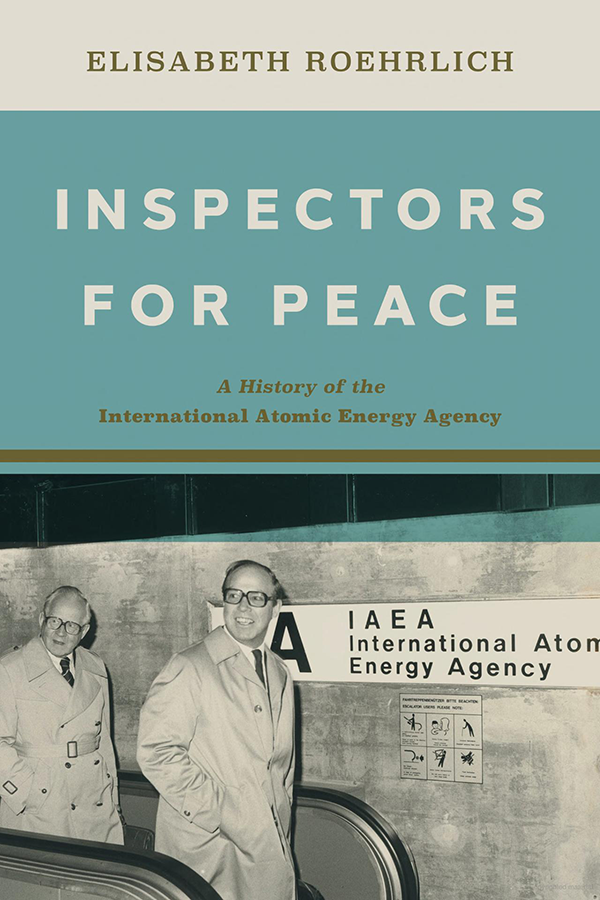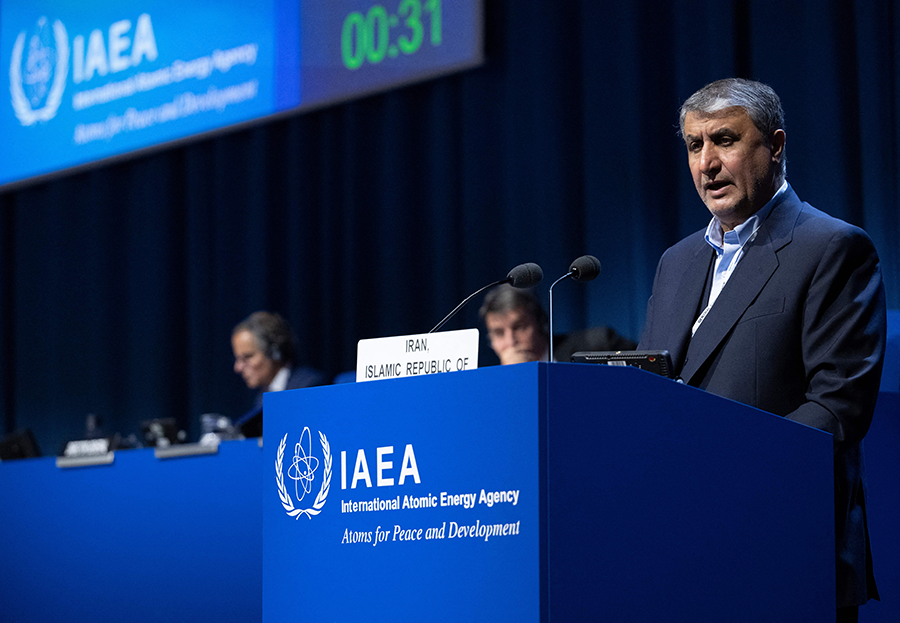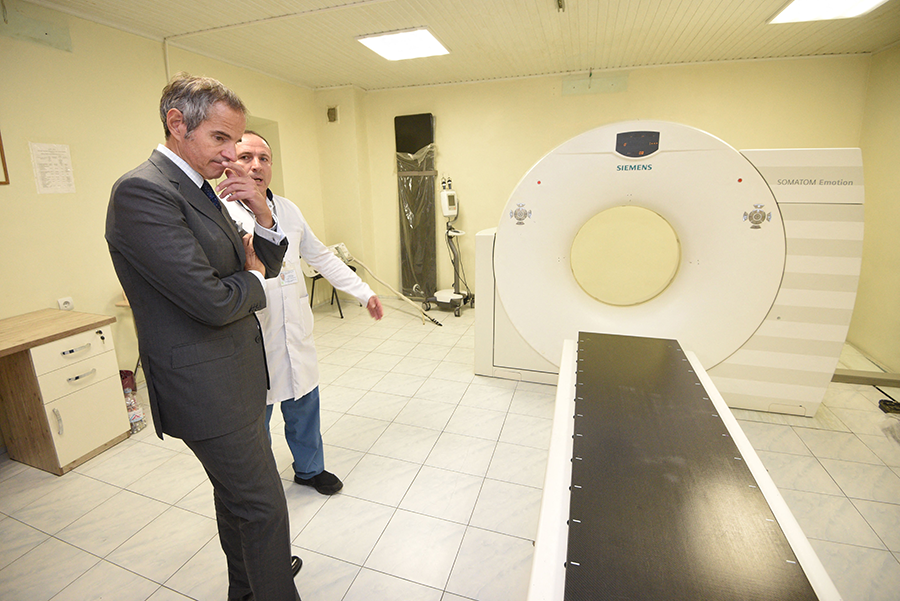"Though we have achieved progress, our work is not over. That is why I support the mission of the Arms Control Association. It is, quite simply, the most effective and important organization working in the field today."
Inspectors for Peace: A History of the International Atomic Energy Agency
November 2022
 The Evolution of a Nonproliferation Icon
The Evolution of a Nonproliferation Icon
Inspectors for Peace: A History of the International Atomic Energy Agency
Elisabeth Roehrlich
Johns Hopkins University Press, 2022
329 pp.
Reviewed by Kelsey Davenport
For nearly 70 years, the International Atomic Energy Agency (IAEA) has been at the forefront of some of the most significant international crises. From assessing the safety and health implications of the reactor meltdowns at Chernobyl in 1986 and Fukushima in 2011 to providing technical assistance to address food insecurity and improve public health, the IAEA’s broad mandate has a global impact. The agency has become associated most closely, however, with its role in preventing the proliferation of nuclear weapons. Its work in investigating the misappropriation of peaceful nuclear technology for illicit weapons purposes in states such as Iran, Iraq, and North Korea has repeatedly thrust the agency into the international spotlight and earned it the nickname of “nuclear watchdog.”
The IAEA’s role in verifying that materials and technologies are not diverted from peaceful nuclear programs, a process known as safeguards, was not a foregone conclusion. The concept of safeguards was first raised in 1945, when Canada, the United Kingdom, and the United States issued a statement supporting the spread of nuclear technologies for peaceful purposes but stipulating that certain knowledge would not be shared until appropriate safeguards were in place. That statement and subsequent discussions in the UN Atomic Energy Commission (UNAEC) in the late 1940s raised some fundamental questions about how safeguards would be applied and the consequences for violating them. It was not until after U.S. President Dwight Eisenhower’s Atoms for Peace speech in 1953, which envisioned an agency that would assist states in accessing the technology and materials needed for civil nuclear applications, that negotiations would commence on establishing the IAEA.
Eisenhower’s Role
Eisenhower’s speech did not mention safeguards, but it included an idea for the Soviet Union and the United States to donate fissile material to a stockpile administered by the agency from which states could draw for civil applications, such as nuclear research. Although the primary purpose of the agency would be to advance peaceful nuclear technology, Eisenhower saw an arms control benefit in pressuring the Soviet Union to relinquish a significant quantity of its nuclear materials, thus limiting the potential size of any future Soviet nuclear arsenal. Although the United States ultimately abandoned the idea of a Soviet-U.S.-supplied international stockpile of nuclear materials during negotiations to form the IAEA in the early 1950s, the prospect of sharing nuclear materials and technologies raised concerns about states diverting nuclear materials from civil to military programs. This realization underscored for negotiators the importance of including a safeguards role for the agency.
Even so, it remained an abstract concept. Negotiators struggled to articulate how measures to verify that nuclear materials would not be diverted for weapons purposes would work in practice, prompting developing states to view the concept of safeguards and inspections of nuclear facilities as an attempt by the great powers to limit access to the benefits of nuclear technology. Perhaps nothing reflects the slow development of safeguards more clearly than the fact that the first inspector was not hired until two years after the IAEA was established and the first safeguards inspection was not conducted until 1962.
In Inspectors for Peace: A History of the International Atomic Energy Agency, author Elisabeth Roehrlich provides a masterful, detailed account of the agency’s evolution and the external events that have shaped its mandate, particularly what has become its most well-recognized and, at times, contentious role: the application of safeguards. Her focus on key events that highlight the paradox of the IAEA’s dual role—it promotes nuclear technologies and materials for peaceful civil applications and energy production even while deterring their use for military purposes—illustrates how these seemingly conflicting priorities were necessary to generate and sustain international support for the agency. It was a carrot-and-stick approach. Providing states with access to nuclear technology was a necessary trade-off to ensure control over how those technologies would be used.
Archival Data
 Although many themes and events in the book, such as the role safeguards played in negotiations over the nuclear Nonproliferation Treaty (NPT) and the IAEA response to Chernobyl, are well documented in other works, Roehrlich’s access to IAEA archival materials that were only made available after 2016 and extensive interviews offer unique insights and perspectives into the agency’s work. Her decision to begin the narrative prior to the agency’s establishment also rewards the reader with a more detailed understanding of how great-power thinking about proliferation threats and the means to prevent further nuclear-armed states evolved from the end of World War II, particularly for the United States. This early history provides a critical backdrop for understanding why IAEA safeguards were initially so weak and were applied only to select nuclear facilities in a few states.
Although many themes and events in the book, such as the role safeguards played in negotiations over the nuclear Nonproliferation Treaty (NPT) and the IAEA response to Chernobyl, are well documented in other works, Roehrlich’s access to IAEA archival materials that were only made available after 2016 and extensive interviews offer unique insights and perspectives into the agency’s work. Her decision to begin the narrative prior to the agency’s establishment also rewards the reader with a more detailed understanding of how great-power thinking about proliferation threats and the means to prevent further nuclear-armed states evolved from the end of World War II, particularly for the United States. This early history provides a critical backdrop for understanding why IAEA safeguards were initially so weak and were applied only to select nuclear facilities in a few states.
For instance, Roehrlich discusses reports commissioned by the United States to inform its approach to the UNAEC negotiations. The reports emphasized that on-site inspections would not be sufficient to prevent proliferation and that safeguards violators should be punished swiftly. The United States would move away from these expert recommendations in negotiations to establish the IAEA and to establish safeguards provisions in the NPT. Interestingly, the IAEA’s lack of enforcement mechanisms, the slow process of referring noncompliant states to the UN Security Council for action, and the inadequacy of limited on-site inspections would be exposed later as gaps in the agency’s safeguards mandate that states, such as Iran, exploited.
The Safeguards Debate
The principles that safeguards should be minimally invasive and narrowly construed to apply only to the nondiversion of nuclear materials overrode these earlier U.S. concerns during safeguards negotiations in the 1960s and 1970s, including in the committee that was established in 1970 to develop guidelines for the NPT-required safeguards. Lobbying by states supplying source materials, especially uranium, resulted in these materials being exempted from safeguards under the guidelines developed by the committee for negotiating safeguards agreements, another loophole that complicates IAEA safeguards efforts.
Although these limitations may have been necessary to secure international support for safeguards guidelines, they underscored the weaknesses in the tools available to the IAEA that states exploit even now. Recognition of these weaknesses eventually prompted negotiations to strengthen the agency’s safeguards role. Roehrlich examines the cases that exposed these gaps—Iraq, North Korea, Libya, and Iran—and the negotiations on what became the 1997 Model Additional Protocol, the basis for a supplement to a state’s safeguards agreement, in the penultimate chapter of the book. Although conclusion of an additional protocol with a state significantly strengthens the IAEA’s safeguards mandate by providing inspectors with greater access to information about a country’s nuclear program and its facilities, it remains a voluntary commitment. Several states have refused to negotiate an additional protocol with the agency, citing concerns about great-power attempts to make access to nuclear technology overly burdensome. These arguments are similar to those voiced during debates over safeguards in the 1950s.
The negotiation of the NPT led to a significant expansion of the IAEA’s safeguards role and renewed debates over how to design a comprehensive safeguards approach. These discussions, which took place primarily in the safeguards committee set up in 1970, show that states believed that safeguards would deter states from pursuing nuclear weapons development, and they pursued a model reflecting that approach. As Roehrlich’s primary source material highlights, states involved in the safeguards negotiations also believed that the risk of public exposure of illicit nuclear activities, denial of access to further technical cooperation, and IAEA referral of noncompliance to the UN Security Council, which could lead to sanctions, would be sufficient to prevent states from diverting nuclear materials and technologies to military programs. Her discussion of India’s nuclear test in 1974 and the clandestine nuclear weapons programs in Iran, Iraq, and North Korea underscored the weakness of this approach and how determined proliferators were able to take advantage of gaps in the safeguards regime to exploit civil nuclear programs for illicit purposes and were not deterred by the potential consequences.
In the 1970s, the safeguards committee also debated whether IAEA inspectors should be limited to trusting the nuclear declaration provided by a state or whether they could independently question and verify that information, including by using intelligence shared with the IAEA by member states. Roehrlich details how the United States supported the latter, stricter approach, arguing that if the IAEA is to carefully scrutinize a state’s nuclear declaration, it must be able to obtain and use additional sources of information. Her analysis of the committee’s records shows that, despite general agreement among members of the sanctions committee that the IAEA should be able to verify and scrutinize a state’s nuclear declaration, the guidelines that were finally adopted did not define verification and only required states to share the minimum amount of information necessary for the IAEA to carry out its work. Meanwhile, the IAEA’s use of intelligence from member states to check state declarations remains contested. Iran in particular continues to argue that the evidence on which the IAEA has relied to accuse Tehran of operating an illicit nuclear weapons program prior to 2003 was manufactured by Israel.
Soviet-U.S. Cooperation
Of special interest, given current geopolitics, is the extent to which the United States and the Soviet Union were willing to cooperate to establish and strengthen safeguards, even at the height of the Cold War. Throughout the book, there are countless examples of how the shared goal of preventing proliferation, particularly after the Cuban missile crisis, was critical in expanding and strengthening safeguards and empowering the IAEA inspectorate. This cooperation enabled the negotiations in 1964 and 1965 that developed IAEA guidelines for safeguarding and inspecting all types of nuclear reactors and efforts in the 1970s that developed the guidelines for NPT-required safeguards. The superpowers even recognized the limitations of the IAEA in controlling the spread of dual-use technology and cooperated on establishing voluntary, independent export controls for dual-use technologies, leading to the establishment of the Nuclear Suppliers Group in 1975.
As Roehrlich notes, this history of cooperation sometimes came at the expense of support for allies. For example, the United States prioritized reaching an agreement with the Soviet Union on an NPT text over its plans to expand nuclear weapons sharing with European allies and opposed proposals made by certain European states during the NPT negotiations to self-inspect because of their concerns that safeguards would become a tool of industrial espionage.
 The strength of this past cooperation raises the question as to whether tensions between Russia and the United States over contemporary crises, such as Iran and North Korea, are an aberration or mark a new era when geopolitics trumps shared nonproliferation priorities.
The strength of this past cooperation raises the question as to whether tensions between Russia and the United States over contemporary crises, such as Iran and North Korea, are an aberration or mark a new era when geopolitics trumps shared nonproliferation priorities.
For instance, although the six countries that negotiated the nuclear deal with Iran in 2015 managed to prevent Russia’s invasion of Crimea from disrupting unity in those nuclear talks, Russia attempted to use this year’s negotiations to restore the Iran agreement, officially the Joint Comprehensive Plan of Action (JCPOA), to pursue relief from sanctions imposed by the United States after Russia’s invasion of Ukraine. Moscow backed off this approach when it became clear that its demands jeopardized reaching an agreement on the JCPOA. At the same time, Russia has resisted using the IAEA Board of Governors to censure Iran for failing to cooperate with the agency’s investigation into past Iranian nuclear activities and opposed efforts by the UN Security Council over several years to tighten restrictions on North Korea for illegal missile testing.
New Tensions
The IAEA’s past triumphs in navigating between the East and West at the height of the Cold War may offer valuable lessons for nuclear cooperation as tensions rise between Russia and the West over Russia’s invasion of Ukraine and its illegal occupation of the Zaporizhzhia nuclear power plant.
The events examined by Roehrlich demonstrate the IAEA’s challenges as a technical organization operating in a political environment. She analyzes how states have used the agency’s various policymaking organs, such as the more selective and powerful Board of Governors and the inclusive General Conference, to advance political agendas. These include the push to condemn South Africa’s apartheid regime and strip the country of its place on the IAEA board in 1977 and the consolidation of the Group of 77 lobbying efforts to place greater emphasis on the IAEA’s technical cooperation role, a campaign that continues today. As the author notes, accusing the IAEA of “politicizing” an issue has become standard practice for indicating disagreement with the agency’s approach.
The book underscores how certain unresolved tensions persist, plaguing the agency’s work. After Israel bombed the Osirak nuclear reactor in Iraq in 1981, for instance, the IAEA decided to share confidential safeguards information to support its conclusion that Iraq was not violating its safeguards commitments and challenge Israeli allegations that Iraqi President Saddam Hussein intended to use the reactor to produce material for a nuclear weapons program. The decision to periodically make information about safeguards and the status of a country’s nuclear program public, such as in the case of Iran, remains contentious. Opposition to sharing information continues to demonstrate the tension between using greater transparency to provide assurances about the state of a country’s nuclear program and protecting safeguards confidentiality.
Readers looking for a comprehensive history of the IAEA’s evolving technical assistance role may be left wanting. Even so, the book provides valuable insights into how the safeguards mission impacts the IAEA’s role as a nuclear technology promoter and how safety and security crises affect the agency’s positioning in debates over the expansion of nuclear power. Furthermore, the accessibility of the book broadens its appeal beyond the nuclear policy community. Roehrlich’s attention to the organizational and bureaucratic aspects of the IAEA’s work and its adaptation in response to new nuclear crises offers a window into the role that international organizations can play in managing knowledge and establishing norms. She also highlights the challenges of building political consensus in international organizations, particularly when comprised of a diverse group of states with different priorities.
Inspectors for Peace is a tour de force about the IAEA’s history and evolution and thus a must-read for understanding the strengths and weaknesses of the agency’s role in preventing proliferation.
